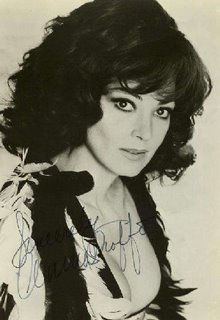 I never got to hear Anna Moffo live. When I started going to the opera in the late 1970's, she had already retired from singing at the MET. All that was left of her, in the early Saturday standing room line where I met other opera fans for the first time, were memories from the old faithful. Record stores loved Anna Moffo's image, though: those wonderful sexy covers on her LP's were always prominently displayed. Her recording of Massenet's Thaïs, which featured a stunning photograph of Ms. Moffo in costume, was a huge best-seller. At that time, I thought that she was the most beautiful opera singer in the history of the genre. And I still do. Physically, I never thought that Maria Callas was a great beauty, although I recognized her visual elegance and grace. But Callas was too European for my tastes in those days. There was something earthy in the way that those pictures made Anna Moffo look. There was something that was closer to home about her. And indeed she was. Born, bred, and educated in the USA. She hailed from Pennsylvania, the daughter of Italian-American parents who loved music. She studied the piano and the viola when she was a voice major at the Curtis Institute of Music in Philadelphia, and was recognized to be an all-around great musician.
I never got to hear Anna Moffo live. When I started going to the opera in the late 1970's, she had already retired from singing at the MET. All that was left of her, in the early Saturday standing room line where I met other opera fans for the first time, were memories from the old faithful. Record stores loved Anna Moffo's image, though: those wonderful sexy covers on her LP's were always prominently displayed. Her recording of Massenet's Thaïs, which featured a stunning photograph of Ms. Moffo in costume, was a huge best-seller. At that time, I thought that she was the most beautiful opera singer in the history of the genre. And I still do. Physically, I never thought that Maria Callas was a great beauty, although I recognized her visual elegance and grace. But Callas was too European for my tastes in those days. There was something earthy in the way that those pictures made Anna Moffo look. There was something that was closer to home about her. And indeed she was. Born, bred, and educated in the USA. She hailed from Pennsylvania, the daughter of Italian-American parents who loved music. She studied the piano and the viola when she was a voice major at the Curtis Institute of Music in Philadelphia, and was recognized to be an all-around great musician.So many opera fans that were lucky enough to have heard her live remember her Traviata, her MET debut, and perhaps her signature role. Her stunning high E-flat was legendary because it was secure, memorable and incredibly beautiful.
In his obituary in the New York Times, Anthony Tommasini wrote the following impressions of the late soprano:
"She died of a stroke after grappling with complications of breast cancer for 10 years. Though Ms. Moffo's career began splendidly, her voice had declined by her late 30's. With her radiant appearance, she was drawn early on into television and film, playing host of her own variety show on Italian television for many years. She might not have fulfilled her promise, but for a good dozen years Ms. Moffo enjoyed enormous success and won a devoted following at a time when her competition for roles like Verdi's Violetta, Puccini's Mimi and Donizetti's Lucia included Maria Callas, Renata Tebaldi and Joan Sutherland. Though Ms. Moffo's voice was not large, it was warm and rich, with soft pastel colorings and a velvety lower range. Agile coloratura technique allowed her to sing high soprano bel canto repertory impressively, especially Lucia di Lammermoor. She was a thoroughly trained musician, having studied the piano and viola when she was a voice major on scholarship at the Curtis Institute of Music in Philadelphia. For a brief time, Ms. Moffo was a lovely singer and appealing artist who broke out of the traditional career mode to reach the larger public. 'You may not like what I do,' she said in a 1972 interview, 'but you can't say I'm dull.'"
No comments:
Post a Comment